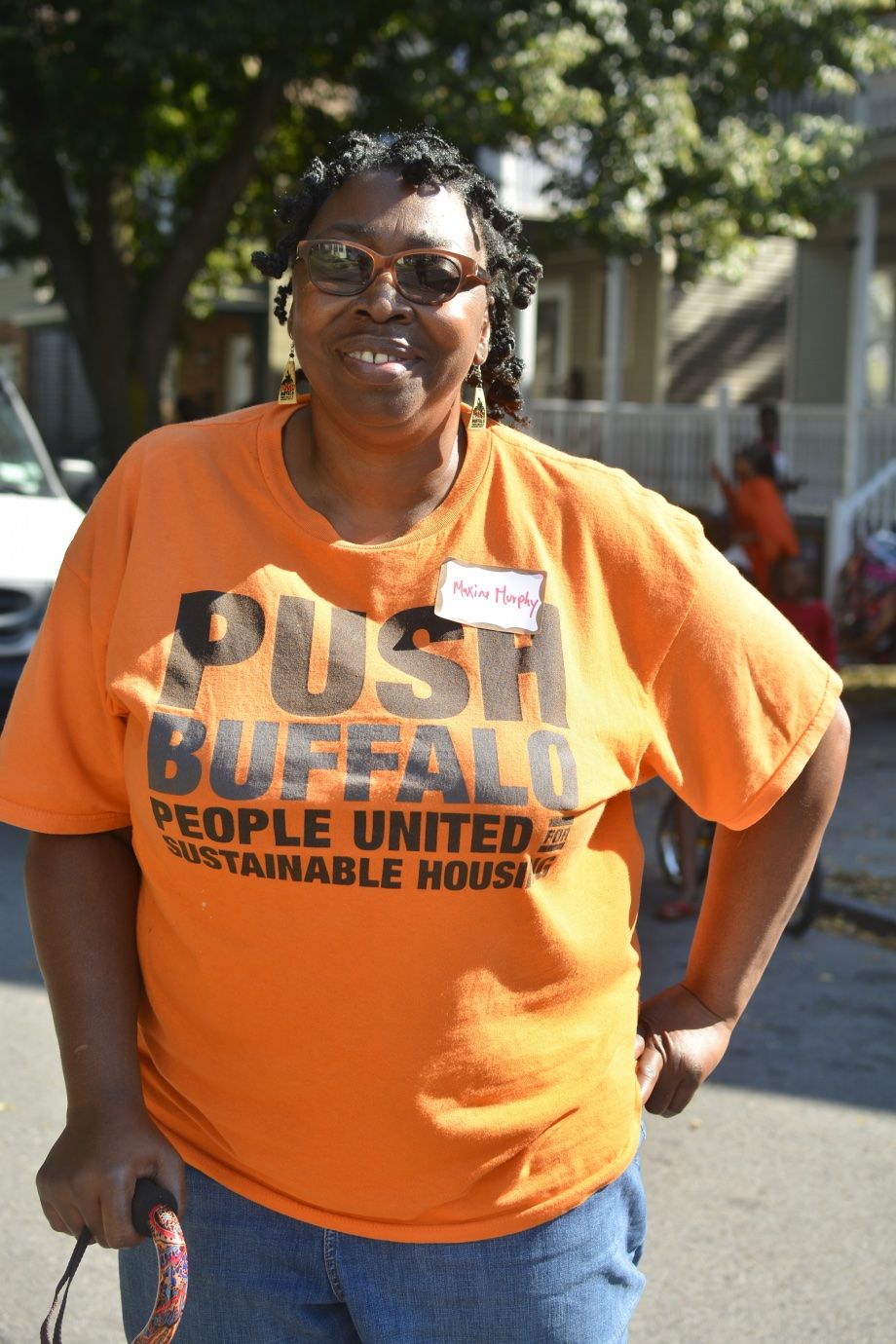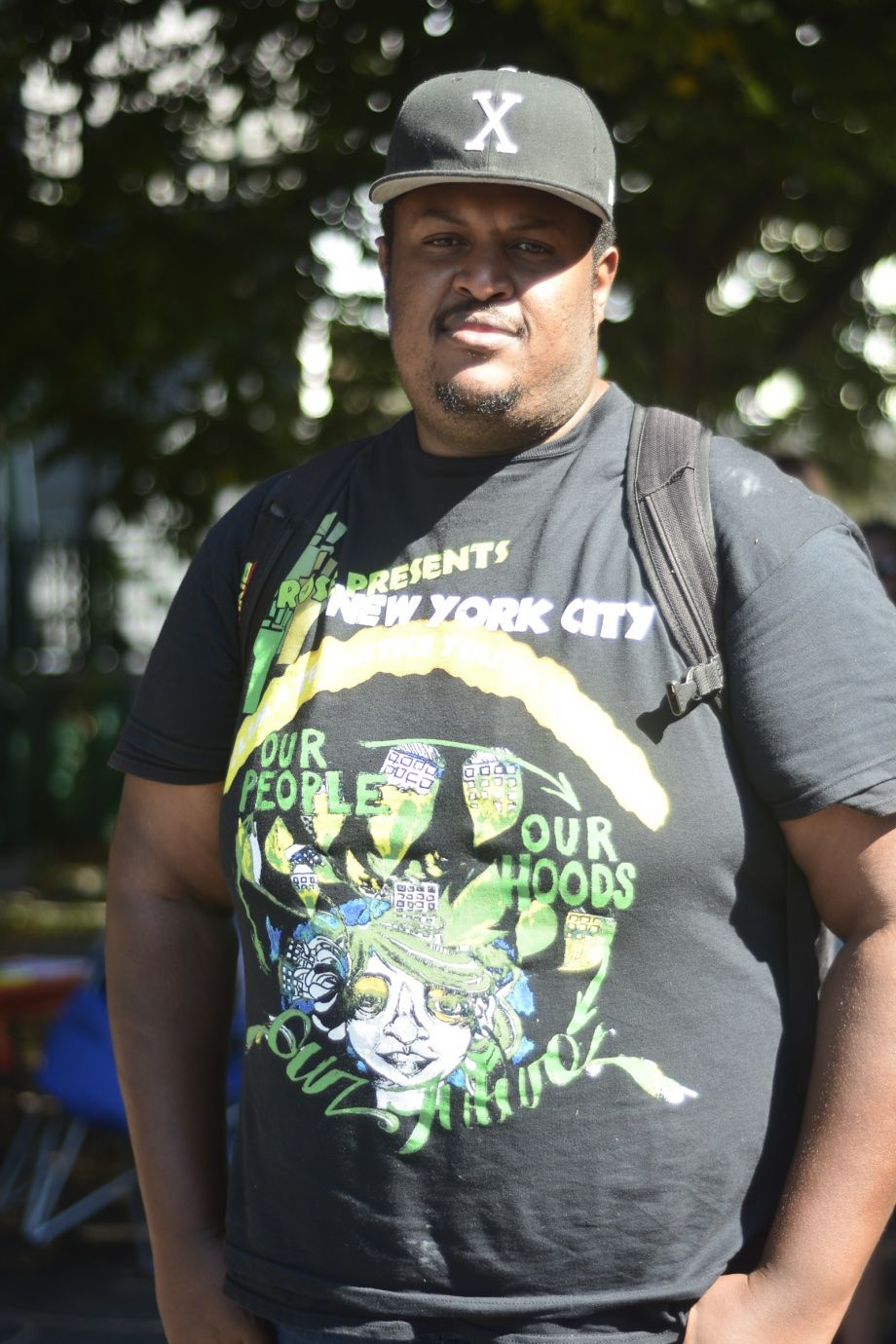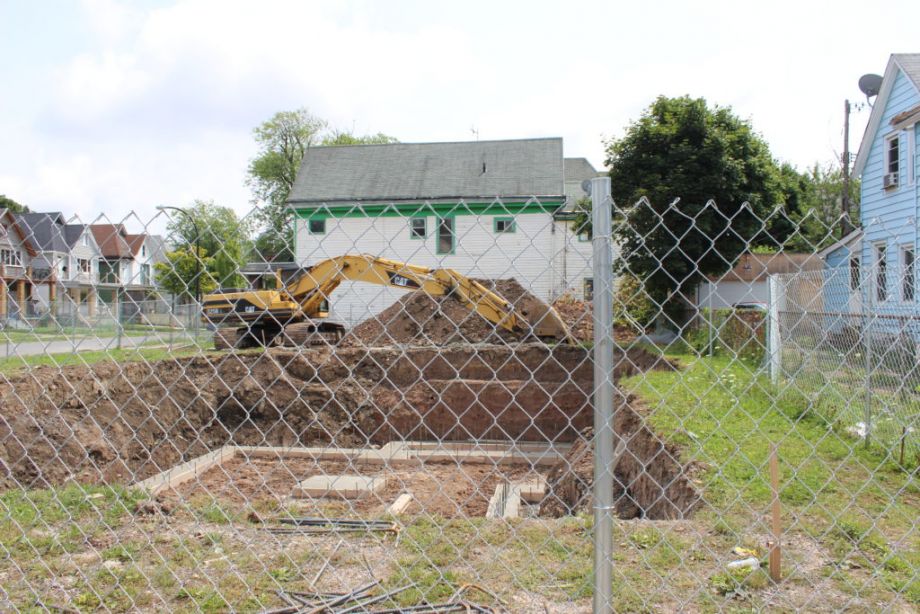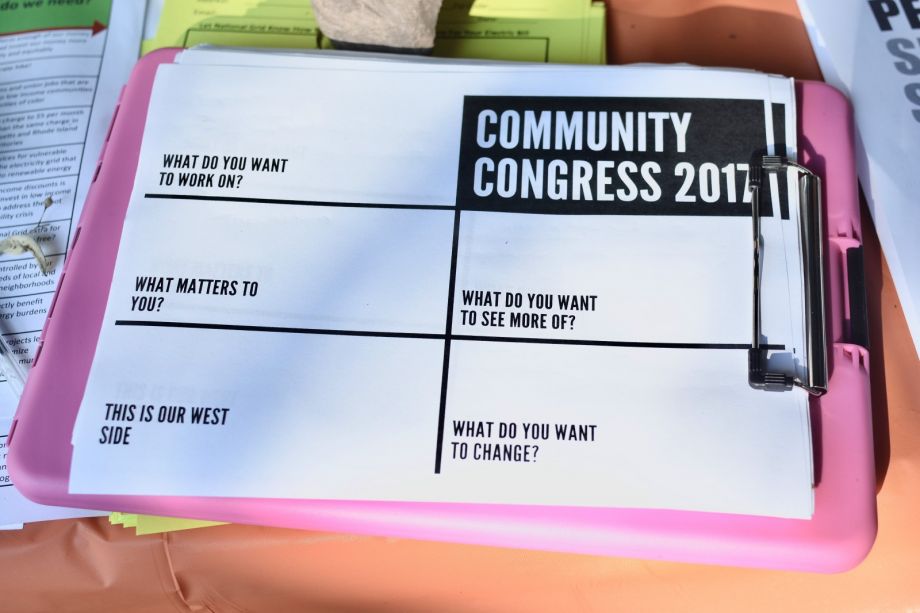Are You A Vanguard? Applications Now Open
This is your first of three free stories this month. Become a free or sustaining member to read unlimited articles, webinars and ebooks.
Become A MemberWhen Maxine Murphy moved to Buffalo’s West Side in 2006, she found a vibrant, diverse neighborhood. It was also full of vacant, abandoned houses; residents were struggling to find good jobs and keep up with rising weatherization costs to make it through the cold Buffalo winters. “I wanted to be part of the solution,” Murphy says.
Murphy quickly found out about a new organization called PUSH Buffalo (which stands for People United for Sustainable Housing) and started volunteering. She’s now president of its board of directors.
“I grew up in Greenville, Alabama,” Murphy reflects. “The black community got involved in civic activism because we had to, it was just what we did at home. It was a matter of life or death.”
Now, many residents of the east and west sides of Buffalo — two long-disinvested neighborhoods now feeling the squeeze of rising rents and property values — think that development in their city is a matter of life or death too.
I met Murphy at a West Side block party on a warm summer day. PUSH had set up a table as part of a new strategy for its community planning efforts this year. Instead of inviting everyone indoors for a long meeting, PUSH’s planning and organizing staff went door to door and showed up at three outdoor community-organized events, and talked to people over hot dogs and the sounds of pickup basketball about what they want to see in their neighborhood.
The responses varied. Many people wanted more playgrounds and positive spaces for youth. Other people spoke about wanting to see more community gardens and more jobs.
But across conversations PUSH has with West Side residents these days, one common theme often emerges: fear of displacement.
The displacement of low-income communities and communities of color is nothing new to U.S. cities. The earliest urban settlements rose on stolen and reappropriated Native land and in the hundreds of years since, there have been countless episodes of black or brown neighborhoods pushed out to make way for other uses, from urban renewal-era highways or housing projects to 1990s schemes for mixed-income communities. But over the past 10 years, organizers working in communities of color in cities across the country have looked up and realized that their residents are experiencing displacement from a new set of forces. In Rust Belt cities like Buffalo, the trend plays out differently than in booming coastal cities like San Francisco and New York. But for all these urban centers, increased public and private investment in downtown neighborhoods combined with changing cultural preferences toward urban lifestyles are changing the fabric of these cities in ways scarcely imagined a decade or two ago.

Maxine Murphy, the leader of PUSH Buffalo's board of directors, at a community event
Measuring displacement is notoriously difficult; cities don’t generally have systems to track data on renters. But recent initiatives by municipal governments and activists across the U.S. are experimenting with ways to measure gentrification, the risk of displacement of low-income and working-class residents, and the complex connection between the two. In one such study from UC Berkeley, researchers found that 48 percent of neighborhoods in the Bay Area are currently experiencing displacement. While Buffalo and the Bay Area are very different places, organizers in both are increasingly grasping for new strategies to respond to concerns from residents who see new people moving into their neighborhoods and rents rising to meet the new demand.
In this arena, PUSH has emerged as a leader with a sophisticated approach that combines neighborhood-level strategies with local and regionwide advocacy around green affordable housing and sustainable development. With a structure unique among community development organizations, the $3 million-a-year nonprofit is a housing developer, political organizing group, workforce development agency, arts hub, green energy firm and more. The mix of programs generates something close to the holy grail in the world of nonprofits: multiple earned revenue streams. With 30 percent of its operating budget coming from green energy work and another 15 percent coming from other sources of earned revenue, the organization has become less dependent on philanthropy and grown quickly, from a staff of six in 2006 to over 50 now, and hundreds of members (membership fees are $5).
With those members, PUSH works both inside the halls of institutionalized government and protests outside of it — a mix of resident organizing and savvy collaboration that has made PUSH an inspiration to many in the community development field.
“PUSH’s work has been a gold standard in comprehensive community development work,” notes Johanna Walczyk of LISC Buffalo. LISC has partnered with PUSH on many projects over the years.
But on the west side of Buffalo, PUSH is more than an inspiration — it is a force. Murphy lives in a net-zero home developed by the organization in an abandoned house, located in the 25-block area PUSH identified in 2008 as the “Green Development Zone” — as a framing to focus housing, workforce and environmental development on one area and build a model for sustainable community-led development. Before PUSH built there, Murphy remembers, the area was dilapidated. “People were using empty houses for criminal activity. The quality of life was not good,” she recalls.
Guided by a collaborative community plan for the neighborhood, PUSH recently broke ground on another major project on the West Side: the redevelopment of a shuttered public school into a community anchor with affordable apartments for seniors, a youth community center and gym, office space for PUSH, and a home for the Ujima Theatre Company. Solar energy will power the School 77 building. Elsewhere in the city, PUSH is supporting a fledgling community land trust and working with the state on a green energy job training program, and is part of a coalition advocating for citywide affordable housing policies.
“Affordable housing is a human right. We have taken abandoned housing, rebuilt it in a sustainable way, and given people an affordable place to live,” Murphy says.
From Murphy’s window, she can see change approaching. The posh Elmwood Village, adjacent to Buffalo State University, is just four blocks from her, on the other side of Richmond Avenue (“the great divide” as it is known). Across that boundary, rehabbed rowhouses run $400,000, affordable to fewer than 10 percent of Buffalo’s population, according to data recently released by the city. A popular neighborhood farmers market and artisanal shops helped earn the neighborhood “one of the 10 best” from the American Planning Association in 2007. The revitalization has bloomed against a backdrop of continued increasing and racialized poverty and deep segregation across the city and growing housing pressures.
Thirty-seven thousand, or 34 percent of the city’s households, live on $20,000 per year or less — while rents are steadily rising. A recent study found that citywide rents have increased 8 to 13 percent annually over the past decade. A 2017 Health Equity study by PolicyLink and PERE showed that higher percentages of people of color in Buffalo are cost-burdened by housing (meaning that they spend more than 30 percent of their income on housing costs).
While there is a dearth of data about displacement and demographic shifts in Buffalo, residents and organizers’ experiences indicate that middle-income populations are increasingly moving into neighborhoods that not long ago weren’t on the map for people who had options in the market. Welcoming these newcomers are not only newly renovated warehouse conversions and chic cafes but promises of a more prosperous Buffalo to come. New York Governor Andrew Cuomo has promised $1 billion to the city through his embattled Buffalo Billion initiative supporting investments in solar, startups, a new medical campus and more.
The change has not gone unnoticed by Buffalo Mayor Byron Brown and his administration.
Earlier this month, Brown’s Office of Strategic Planning quietly shared a draft of a new report on the city’s housing market analyzing affordability needs and offering policy recommendations. The long-awaited “Housing Opportunity Strategy,” was shared a few weeks after activists including Murphy and other PUSH members demanded its release at a City Hall protest. OSP Executive Director Brendan Mehaffy describes the document as an effort to understand affordable housing needs to supplement the 1,600 units that have been built since Brown took office in 2006. Brown did not respond to requests for further comment on the strategy.
The report notes that overall Buffalo is beginning to rebound from difficult years, but that the housing market is only “healthy” in a few neighborhoods — and the widening inequality gap (which is compounded by racial inequity) threatens the entire city’s rebound. The strategy makes several recommendations, including exploring inclusionary zoning, a citywide community land trust and tax exemptions for developments that include affordable units. While some of these policies are similar to those advocated by PUSH and various other community-based groups, the details of execution differ in significant ways. Take community land trusts. Both the city strategy and affordable housing study recommend developing such a structure for affordable housing, but while the city recommends a citywide trust, the local nonprofits advocate for neighborhood-specific initiatives led by residents. PUSH and its allies also recommend a more stringent approach to inclusionary zoning, suggesting that it should be mandatory for developments over nine units, with new developments required for a set-aside of 30 percent of units for people with an income below 60 percent of the area median income. Among the other policy prescriptions included in a response to the city strategy released by the Partnership for Public Good and Open Buffalo is a call to create Green Development Zones, modeled after the PUSH experiment, throughout the city.
For PUSH, its allies and the residents they represent, the question is not whether more housing and development is needed — but who it will benefit. Will new jobs, amenities and opportunities — and the policies in place to guide them — reach only the newcomers and those already connected to resources, or will they also benefit those who have outlasted decades of uneven investment and disinvestment, redlining, urban renewal, highway development and declining wages?

John Washington III says his work with PUSH is centered around “challenging the power system.”
When John Washington III, PUSH’s director of organizing, joined the organization in 2013, he began to notice a pattern. Residents and youth he’d gotten to know through PUSH on the West Side would disappear, and he would find out later that they had moved to the East Side or to suburban Cheektowaga, where rents are cheaper.
Washington’s organizing chops came naturally in some ways. His mother grew up in Harlem in the 1950s and ’60s and was part of the generation of children who participated in the desegregation of schools. She shared her childhood memories and exposed him to human rights activists and black liberation writers. His experience working as a debt collector, selling subprime mortgages to people just to keep himself afloat, drove him to look for a better and fairer way in the Occupy movement, and then on to PUSH.
What he found at PUSH was a community-based organization founded in 2005 by two experienced local organizers. The group began by knocking on doors and supporting resident leadership that could address declining neighborhood conditions.
The organization’s first successful direct-action campaign rose in the midst of an earlier real estate boom. The organizers came together to prevent New York’s Housing Agency from using a fraudulent bundled bond to speculate on the deeds for nearly 1,500 tax-delinquent vacant lots throughout the city — 200 of which were on the West Side. After a direct-action campaign targeting then Governor George Pataki brought the issue to light, the incoming Eliot Spitzer administration worked with PUSH to unravel the bond and transfer the properties back to the city. Several of these properties were ultimately transferred to PUSH, which then began developing them into green and affordable housing — the beginning of the 25-block Green Development Zone. Since then, the organization has amassed nearly 125 properties throughout and near the zone managed through a development wing of the organization, Buffalo Neighborhood Stabilization Corporation. BNSC manages 77 apartments in 26 buildings throughout the GDZ; there’s another 44 under construction. Financing for PUSH’s developments come mainly from the usual assortment of affordable housing development sources — federal HOME and Low-Income Housing Tax Credit financing, state historic tax credits, and funding programs. The supply hasn’t been able to keep up with demand: There is a 400-person waiting list for affordable units.
Another piece of its development strategy is its work as an informal land bank: purchasing and receiving donated properties from city government and private owners and developing them based on what its members and the broader community deem as priorities. Another housing project is its green energy jobs and housing initiative, operated in partnership with New York state. The Push Green initiative trains and places workers in green construction trades and offers solar installation, weatherization, and services to homeowners and companies.
“We partner with PUSH on several initiatives, and hire their workers for our solar development installations,” says Dan Montante, president of Montante Solar. “Since we started working with PUSH, productivity is up, and it’s been wonderful to be able to see Buffalo-born and -bred workers having a local impact in so many ways.”

A PUSH development project underway
The vision powering all of these efforts is humanist at its core. Washington describes the GDZ as a kind of communitarian utopia — where resources are affordable and sustainably managed, shared and self-determined. In this idealistic vision, conflict is managed by social workers and without police, and well-facilitated democratic deliberation is shared over food at least once a week. More than just building a sustainable physical environment, PUSH’s model emphasizes solidarity and collaboration — new social rules — while also building the capacity of the community to support itself.
“We go door to door, and invite people to have one-on-one conversations with us,” says Christian Parra, another PUSH community organizer. The work begins with trusting relationships, and through that trust, uncovering issues that residents are facing. Then, campaigns are built to address those issues.
Building community control over land had always been a consistent thread in the work, with influences such as Dudley Street Neighborhood Initiative in Boston (one of the first and most lauded community land trusts), Van Jones’ Green for All and, more recently, the work of Movement Generation and others who worked on securing community control from day one.
“As we were building our organization, we quickly realized that gaining control over the land was the quickest and most effective way to make sure the community could enact what it wanted over the long term,” recalls PUSH Co-Founder and Executive Director Aaron Bartley. (Bartley recently announced his intention to step down as ED in 2018 to make way for the next generation of community leadership.)
While the term “community development corporation” may conjure the idea of maintaining close ties to a neighborhood, building leadership skills and managing community-based decision-making, that’s not the focus of many CDCs.
But for PUSH and its organizing team, relationships form the backbone of their work. Murphy, Parra and Washington are joined by dozens of other resident leaders who are involved in PUSH’s governance and decision-making. On my visit to Buffalo, I met a former School 77 teacher named Provy Carrion and Zaw Win, a Burmese refugee turned neighborhood entrepreneur and arts organizer, along with many other leaders who call the neighborhood home.
PUSH’s organizing strategy is woven throughout its work. One-on-one relationships built through door knocking and outreach create a foundation for operations with a strategy for community input and democratized decision-making feeding all aspects of the organization, including overall governance through the board of directors, according to staff.
But finding the right balance between top-down and bottom-up planning isn’t always easy. While calls for community-led planning permeate groups around the country, the planning and development field is highly specialized and requires a large amount of technical knowledge. Building the capacity to do this is no easy task.

PUSH asks residents about their priorities at a recent block party.
“We work to build trusting relationships throughout the year — even when there isn’t a project we are working on — so that when we do, we can come to the table and have an honest conversation,” says Jen Kaminsky, BNSC’s housing director.
“Our work is not just rosy and happy. It’s about challenging the power system,” says Washington.
One strategy PUSH tried out this summer to address this issue is called the People’s Summer School. Through a series of small group sessions, the program encourages participants to understand and share their stories of resilience and oppression. Facilitators contribute information about how urban history connects to each person’s story.
“Understanding the political realities that individuals have experienced will lead us to a larger organizing strategy,” Washington says.
A few days after the block party, on another hot August morning, I met up with organizers on the East Side of Buffalo who are building off PUSH’s work to develop a community land trust in a neighborhood called the Fruit Belt.
A small but storied neighborhood, the Fruit Belt was originally home to German and Polish immigrants. African-American families began to heavily populate the area in the ’50s, at the height of a 70,000-person-strong wave of midcentury black migration to Buffalo — after urban renewal forcibly displaced existing black residents from downtown.
In 1958, local authorities started to build the Kensington highway through the neighborhood. Anticipating the road’s negative impacts, the families who had the means to move — many of them white — left for the suburbs. These two things dramatically decreased property values. In the 1980s and ’90s as jobs continued to flow out of the deindustrializing city, the Fruit Belt’s population further declined and the city pursued an aggressive demolition strategy. By the time the bulldozers left, the neighborhood was dealing with a large number of vacant properties, and residents without a source of equity. By 2016, the area was 83 percent African-American, with a median household income of $20,047.
With an eye toward bringing more investment into the area, Mayor Brown is working to expand the Buffalo Niagara Medical Campus (BNMC), which is adjacent to the gridded residential neighborhood. The medical campus and its neighbors have a fraught relationship. Fruit Belt residents call the campus “the wall” — in reference to the sense that the neighborhood stands apart from the institution and is excluded from its benefits. Many longtime residents fear they will be pushed out of the area as the school grows and property values increase.
After winning a temporary parking permit process to ensure that seniors in the neighborhood can continue to park on their blocks (professionals and students from the BNMC were parking in the neighborhood to avoid high parking lot costs), organizers are working to respond to the increasing housing pressure brought on by the BNMC. Already, some homeowners in the area have received notices from the city of property assessments increasing while some renters have found their rents rising by huge jumps in response to hotter markets adjacent to the new campus.
“I’m worried that my kids won’t be able to afford to live in the neighborhood that raised them,” says Dennice Barr, one of the lead organizers working on the community land trust.
Next up is developing community-led real estate strategies. They will be based on the three pillars of the trust: 100 percent community control of land, development without displacement, and a spirit of unity, Barr and others say.
Already, the Fruit Belt Community Land Trust (FBCLT) has identified 200 city-owned properties in the nine-block neighborhood and begun advocating for their transfer to the nascent trust. With a moratorium on selling these properties now in place, organizers are hopeful. But if the block on sales is lifted, residents fear the properties will get snatched up by developers looking to profit from public investments nearby and build housing that won’t be affordable to the existing community.
“What’s happening is reverse white flight,” says India Walton, a Buffalo resident and organizer with Open Buffalo, a coalition of community groups that includes PUSH and other organizations doing economic and social justice work in the city.
The FBCLT is having trouble keeping up with the rapidly rising housing prices in the neighborhood. At October’s foreclosure auction, a property in the neighborhood assessed at $11,300 sold to a private bidder for $44,000. The city’s Housing Opportunity Strategy admits that the Fruit Belt may see an increase in housing prices. But while both the strategy and the FBCLT advocate for a land trust, the recommendations differ crucially — whether the land trust would be controlled locally, by the existing community, or by the city.
In fact, the regional land bank — the Buffalo Erie Niagara Land Improvement Corporation, or BENLIC — was formed in 2012 to acquire properties in tax foreclosure or otherwise blighted. Jocelyn Gordon , BENLIC’s executive director, notes that the main value of the land bank is to use its “Super Bid” power at auctions (effectively meaning that properties cannot be sold to anyone else) to take land off the increasingly lucrative speculative market and transfer it into responsible ownership.
Mehaffy from the Office of Strategic Planning is also chair of the BENLIC board of directors. The organization does not have restrictions in place for those who receive its properties to maintain prices affordable for low-income residents. But Gordon notes that they are willing to work with the FBCLT “if they show they can competently steward the land.”
Mehaffy echoes this sentiment. “We want to see that any entity will be responsible with properties,” he says.
Organizers from the Fruit Belt say that the city should be confident in the ability of the organization to manage the property given the long history of community-driven property maintenance amid city disinvestment. Government should offer technical assistance and support if capacity is a question, they say.
“The city may not think the community can do it … but we see residents being brilliant,” says Harper Bishop, one of the organizers behind the FBCLT and the economic and climate justice coordinator for Open Buffalo.
PUSH is a rare breed among community development organizations, with much of its success and growth tied to a mix of organizing and development activities that would be out of bounds to the many community development organizations that shy away from political advocacy.
But the organization’s wins indicate that their peers may, in fact, not have to choose between advocacy and close partnership with city and state governments. In fact, a local strategy combined with a regional one might be exactly what is needed to make a greater impact.
“We may not be able to win the fight for community control just by working lot by lot. We need to go bigger,” Bishop reflects, echoing veteran land trust leader John Emmeus Davis in the recent academic exploration of land trusts, “What a City Is For.”
Many municipalities feel stuck between the need to generate tax revenue through development and the fear of displacing residents when rents rise as a result of this increased development. But as Henry Louis Taylor Jr., a professor at the University of Buffalo, says, “If you play the long game in neighborhood revitalization, costs go down when equitable investments are made. Cities can be more creative around taxation and spending.”
The question then becomes how creative can cities get — and groups like PUSH are leading the fight to figure that out, with a hopeful, collaborative and greener future at the core of its vision.
In the case of the rising affordability crisis and displacement around the country, the productive tension playing out on the east and west sides of Buffalo are changing the development landscape — and creating new possibilities.
“Every time we challenge the structure, new political realities that seemed impossible become plausible,” says Bishop.

Danya Sherman is an urban & cultural planner who specializes in collaboratively developing strategy, research, and programs that work towards a more creative and just society. She is currently a Research Consultant to ArtPlace America, the Center for Performance and Civic Practice, a contributing writer for Next City, and the Case Study Initiative Project Manager at the MIT Sam Tak Lee Real Estate Entrepreneurship Lab. Previously she founded and directed the Department of Public Programs & Community Engagement at Friends of High Line. She holds a Master's in City Planning from MIT and a Bachelor of Arts from Wesleyan University.

20th Anniversary Solutions of the Year magazine